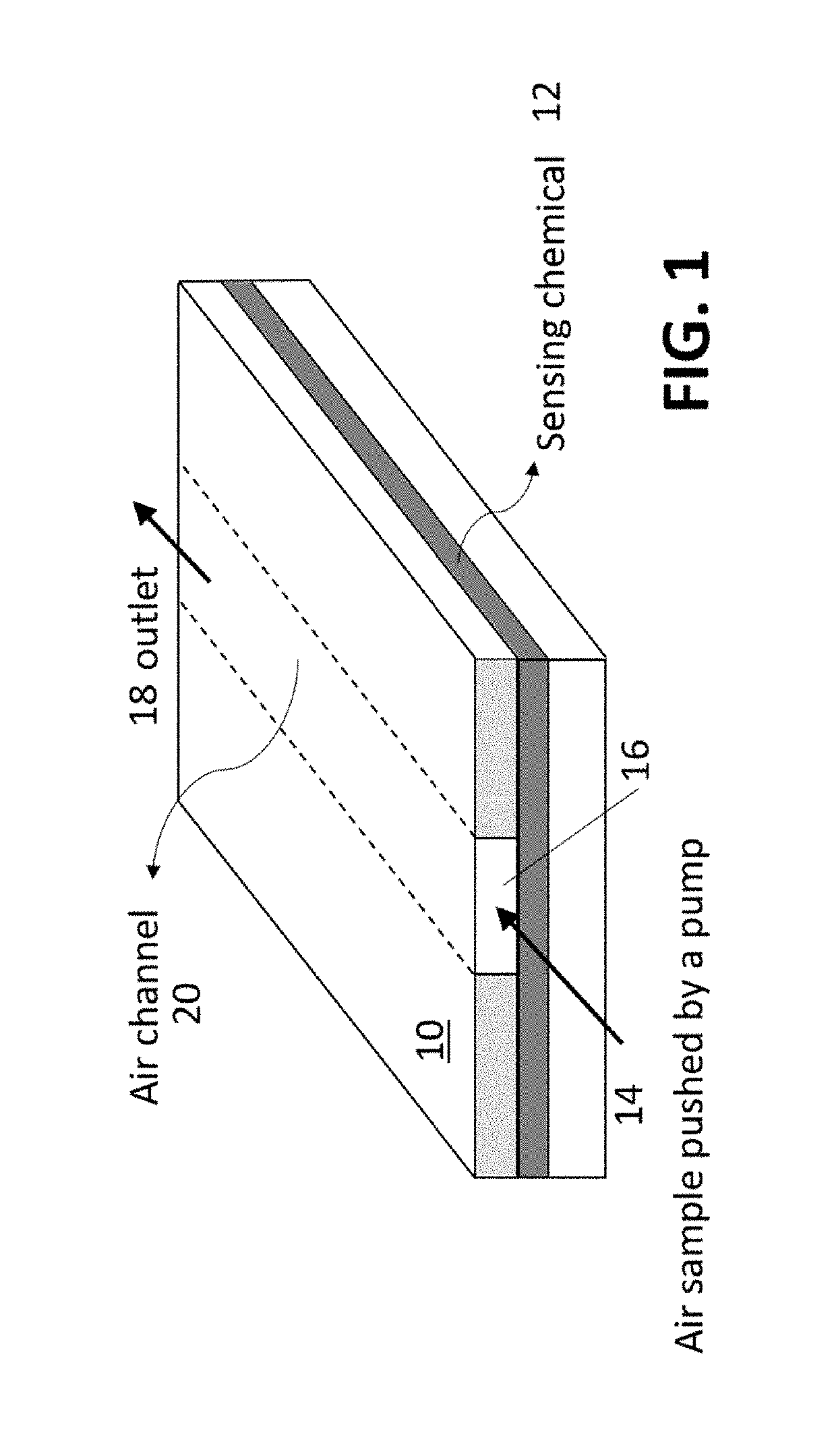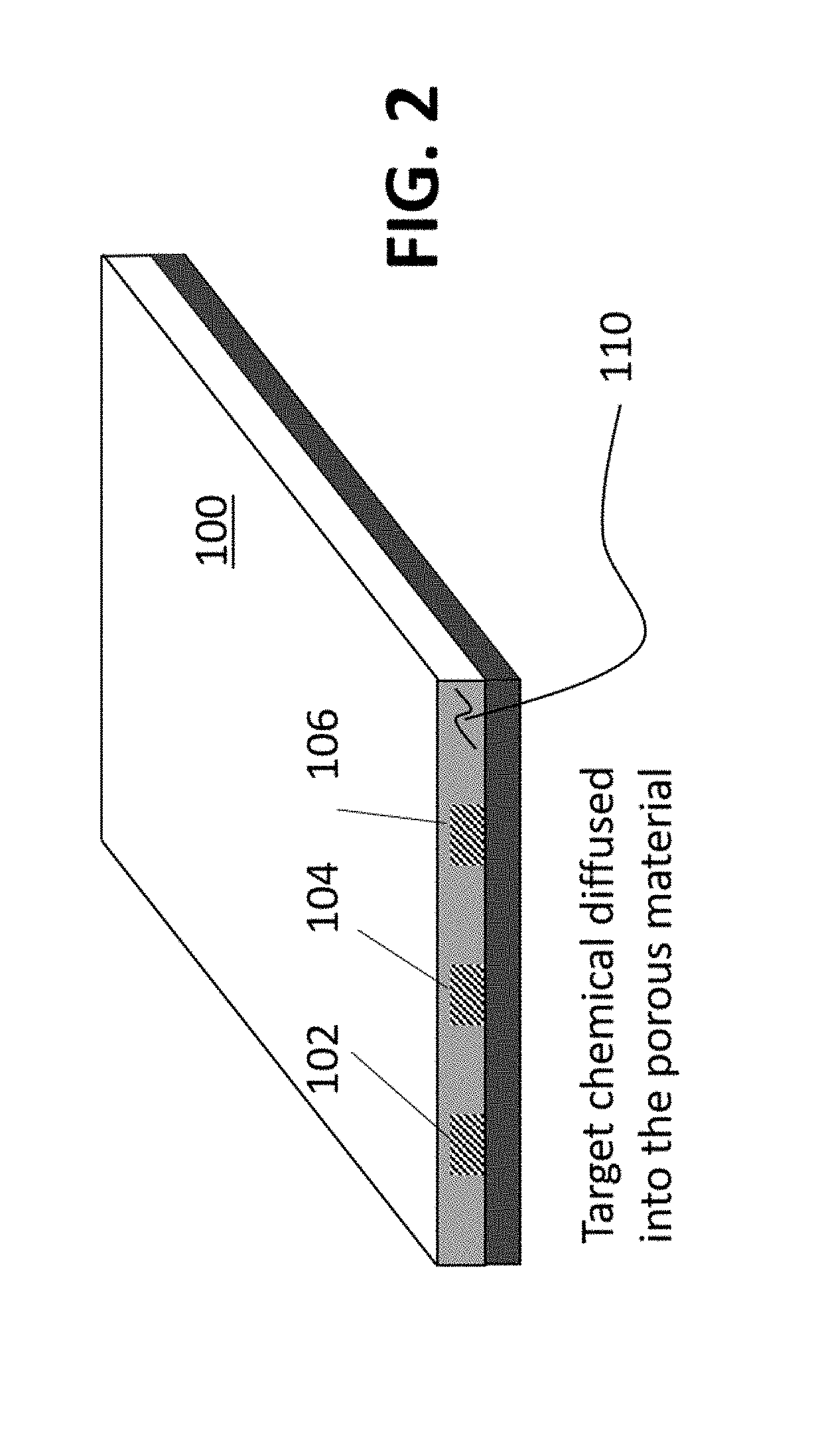Method and apparatus for continuous gas monitoring using micro-colorimetric sensing and optical tracking of color spatial distribution
a color spatial distribution and micro-colorimetric technology, applied in the field of continuous gas monitoring using micro-colorimetric sensing and optical tracking of color spatial distribution, can solve the problems of limited to a single analyte in one sensor, poor selectivity, and high power consumption, and the need for frequent calibration
- Summary
- Abstract
- Description
- Claims
- Application Information
AI Technical Summary
Benefits of technology
Problems solved by technology
Method used
Image
Examples
example embodiments
[0039]Referring now to FIG. 2, an example of a micro-colorimetric sensor is shown. wherein parallel linear channels of porous media are fabricated. A micro-colorimetric sensor 100 includes a plurality of parallel linear channels of porous media 102, 104, 106. Each linear channel includes a sensing material for one or several specific target chemicals in air. Each line can be separated by material 110 or can be next to each other. In some examples the porous media is selected from the group consisting of silica gel, cellulose, polymers, porous glass, silicon, metal oxides, metal nitrides, zeolites and combinations thereof.
[0040]Each of the sensing chemicals is selected for a particular target chemical, so that the sensor can simultaneously detect multiple chemicals. Air sample diffuses passively along each linear channel without using a pump, and the target chemical in the air sample reacts with the sensing chemical in the linear channel, starting from the inlet, which creates a colo...
example 1 continuous
Monitoring of Ozone Using Micro-Colorimetric Sensing and Optical Edge-Tracking
[0043]One example of micro-colorimetric sensor for continuous O3 monitoring was manufactured by a porous media and chemically responsive compounds. The porous media in this example was silica gel plate, purchased from Sorbent Technologies (Polyester backed silica G TLC plates). The silica gel plate was cut into 0.5 mm (width)×4 mm (length) small pieces and immersed in an aqueous solution with formulation of Indigo carmine and citric acid. Following by a 2-hour vacuum drying process, the micro-colorimetric O3 sensor was then covered with a piece of Acrylic and fixed by screws. The micro-colorimetric sensor was illuminated with a white LED (LEDtronics Inc.) and imaged with a CMOS imager (Logitech, Inc.) for real-time monitoring of the color progression continuously when exposed to O3 (FIG. 1a).
example 2
Micro-Colorimetric Sensor Array for Detection of Nitrogen Dioxide, Ozone, and Formaldehyde.
[0044]One example of micro-colorimetric sensor array for detection of Nitrogen Dioxide, Ozone, and Formaldehyde was fabricated by inkjet printing method. Silica gel was used as porous media and coated on polyester substrate. Three sensing solutions containing N,N-dimethyl-1naphthylamine, indigo carmine, and hydroxylamine sulfate respectively were prepared for selective detection of nitrogen dioxide, ozone, and formaldehyde. The three sensing solutions were inkjet printed on the porous silica gel layer in the form of three parallel lines. An acrylic plate was then affixed over the top surface of the porous silica layer to cover the three parallel linear channels. FIG. 10 are top views of the sensor array after exposing to ozone, nitrogen dioxide, and formaldehyde. Each sensing channel changed color and a clear color gradient was generated after exposing to the corresponding analyte, and there i...
PUM
 Login to View More
Login to View More Abstract
Description
Claims
Application Information
 Login to View More
Login to View More - R&D
- Intellectual Property
- Life Sciences
- Materials
- Tech Scout
- Unparalleled Data Quality
- Higher Quality Content
- 60% Fewer Hallucinations
Browse by: Latest US Patents, China's latest patents, Technical Efficacy Thesaurus, Application Domain, Technology Topic, Popular Technical Reports.
© 2025 PatSnap. All rights reserved.Legal|Privacy policy|Modern Slavery Act Transparency Statement|Sitemap|About US| Contact US: help@patsnap.com



